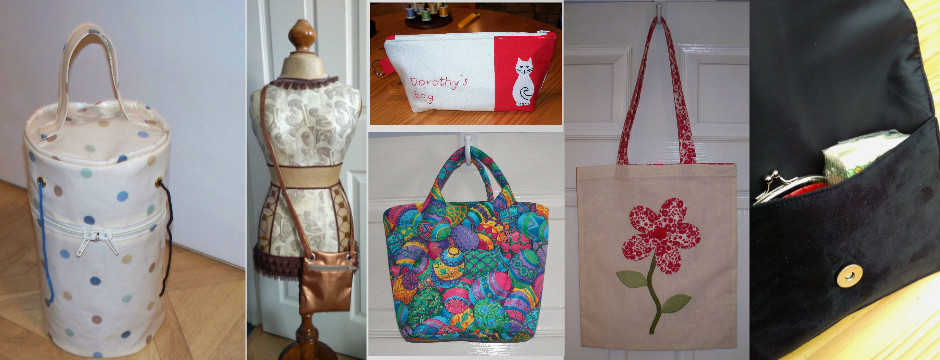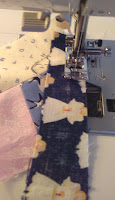I saw a peg
bag like this on a recent shopping trip and immediately knew I could make it
for a fraction of the price. I’ve made a
peg bag before but this is so simple and streamlined that I couldn’t resist
it. The PVC fabric can be wiped clean
and the dowelling rod across the top helps the bag to keep its shape and bear
the weight of the pegs. I used a PVC
with a polyester backing which is really only meant for something like table
covering, but it had been in my stash for some time waiting for an opportunity
in the limelight. It won’t be as strong
and durable as cotton backed PVC (which I would recommend you use) but the bag
cost about £1.50 to make, so it was a bargain. Unusually, I didn't neaten the seams inside the bag, but if you want to, please read right through to the end because you would need to do some of the steps in a different order.
You will need
about half a metre/yard of PVC but it is not suitable for a directional fabric
as either the back or front would end up with an upside down design.
The finished
size is 10” high x 9¾” wide (25 cm x 24.5
cm). The strap can be as long or short as you want it to be - measure before you cut it out. The joy of
making your own bags is that you can make them the right size for you. Before attaching the shoulder strap, drape a
tape measure across your shoulder and body as if wearing a messenger bag and
decide on the right strap length for you, then cut the strap to size. It’s
almost couture!
I bought the dowelling from my local hobby store but DIY stores sell it too.
I used my
general purpose foot and a woven fabric needle (although a leather needle works
well on stronger cotton-backed PVC). The seams were sewn with my normal stitch
length (2.5) but for the top stitching, I increased the stitch length to 3.
Using pins
will leave visible holes in the fabric, so clips are essential instead.
I have
included metric and imperial measurements but they are not exactly
interchangeable, so you should stick to either one or the other.
Skills used in this project:
- Using PVC
- Keeping it simple
Step 1: Cutting out
Cut the
following pieces from PVC (the 10½”/26.5 cm ends will be the top and bottom):
19” x 10½” (48
cm x 26.5 cm) Bag Body (Cut 1)
7” x 10½” (18
cm x 26.5 cm) Upper front bag (Cut 1)
4” x 50” (10
cm x 127 cm) Strap (Cut 1)
5/16”
diameter x 9” (6 mm x 22.7 cm) wooden dowelling
Step 2: Making the strap
Fold the
strap in half lengthways and clip. Fold
the raw edges in towards the fold line so that it looks like bias binding.
Top stitch
along both sides of the strap to create a professional finish.
Step 3: Neatening the raw edges
Hem one of
the short 10½”/26.5 cm edges of the bag body by turning the edge under once and
then again so that the raw edge is not visible.
Sew.
Hem one of
the 10½”/26.5 cm of the upper front bag.
It is only necessary to turn this under once. Sew.
Step 4: Attaching the strap
Position the
strap on the right side of the bag body so that the raw edge at the end of the
strap matches the raw edge at the top of the bag fabric This will be one of the short edges of the
bag body (10½”/26.5 cm) – the one without the hem. It should be about ¼”/6 mm
from the side edge so that it will be right at the edge when the side seam will
be sewn. Sew across one end of the
strap, close to the edge to attach the strap to the bag body. Making sure that the strap is not twisted,
sew the other end the same distance from the other side edge.
Place the
upper front, right sides together, over the strap ends and bag body matching
the top raw edge and sew along the side and top seams of the upper front.
Step 5: Inserting the dowelling
Cut the
dowelling to size and sand the ends to make sure that there are no sharp edges
which will eventually make holes in the PVC.
Insert the
dowelling between the upper front and the top of the bag body so that it is as
close to the top seam as possible. Sew a
line of top stitching under the dowelling, as close to it as you can get, to
keep it in place. Using a zip foot will enable you to get closer to the
dowelling.
Sew along the
bottom of the upper front to attach it firmly to the back of the bag body.
Step 6: Assembling the bag
Fold the
other short end of the bag body up so that the right sides are facing out and the hem is
2”/5 cm from the top. Fold the sides under by ¼”/6 mm. Top
stitch along these side seams.
Now fill your
bag with pegs, fling it across your body messenger style and you will be able
to hang out your washing with panache.
In this project I learnt:
- I love using PVC. The matte versions (like this one) are easier to sew than the shiny ones which can stick to the sewing machine foot and needle plate. I bought a roller foot but haven’t needed to use it yet as my ordinary machine foot worked perfectly adequately. I’m much more confident than I first was when using this potentially difficult fabric and I’m always pleased with the results as it is so forgiving.
- This was a simple bag with just 2 pattern pieces for the bag and one for the strap. I didn’t line it or neaten the internal seams as the inside is barely visible (it’s the first bag I’ve made with un-neatened seams) and PVC doesn’t fray. This was quick to make as I didn’t have to add a zip or hardware – the only thing that made it bit awkward was the wooden dowelling and that’s why I left it as late as possible before inserting it. If I was making it again, I’d use a better quality fabric, but that’s the only thing I would change.
- If I decided to make this as a gift or to sell, I would neaten the seams. This would require a re-think of the order in which the bag is made. I couldn't sew the final seams from the wrong side of the PVC because the dowelling made it impossible to turn the fabric through. Instead of inserting the dowelling early on, I would leave a gap at the top of one side through which it could be inserted last of all. Then I would be able to sew all the seams with the right sides of the fabric together (in the same order as above). I would then sew binding over the raw edges to enclose them, turn the bag right sides out, slip in the dowelling and then sew up the small gap in the side seam.





















































